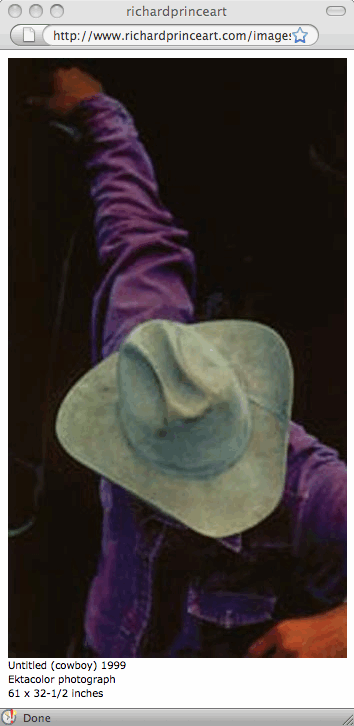Richard Prince, the “appropriation” artist whose work is exhibited at the level of the Guggenheim and sets records at contemporary art auctions, will have to defend himself in a copyright-infringement lawsuit brought by photographer Patrick Cariou. He told citifile that Prince’s recent works use a number of Cariou’s photographs.
According to Cariou, the images used by Prince as part of a recent body of work first appeared in Cariou’s book Yes Rasta in 2000 and were used by Prince without permission or compensation. Cariou’s infringement complaint also includes Lawrence Gagosian, the Gagosian Gallery and Rizzolli International Publications, who respectively exhibited and published a book about Prince’s latest work.

Prince, who previously settled at least one similar lawsuit out of court, makes what contemporary critics and connoisseurs have recognized as art by photographing, enlarging and exhibiting images from print ads. His adaptation of the Marlboro Man—a picture taken by commercial photographer Jim Krantz and owned by Philip Morris—is among the best known for both the image’s aesthetic and the $1.2 million price it fetched at a 2005 auction.
The caption for the image at left on richardprinceart.com reads: "Untitled (cowboy) 1999, Ektacolor photograph, 61 x 32-1/2 inches." The controversial artist has never denied the origins of his works. He explains the cowboy series by stating: “By cropping and taking a photograph from an already existing picture, you’re in a sense fragmenting the real and attempting to add on, or ‘annex’ it to something more real. … The idea is to promote a ‘where the fuck did you get those’ kind of take. … I’m assuming it would require a spectator with a willingness to be a sucker. And if not a sucker, at least someone who wanted some fun and who spent a lot of times in the movies, and didn’t pay any attention to the credits.”
While Prince’s artist statements have a tendency to elicit strong reactions among the creators of his “subjects,” photo editor Rob Haggart thinks Cariou will have a hard time in court. Haggart thinks that Prince’s conduct may be in line with the fourth fair-use factor provision: it does not “harm either the present or potential market for the copyrighted work.”
Photo attorney Carolyn Wright agrees: “Prince’s art may qualify as transformative work.”